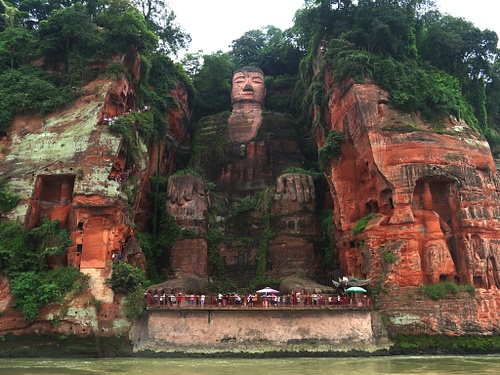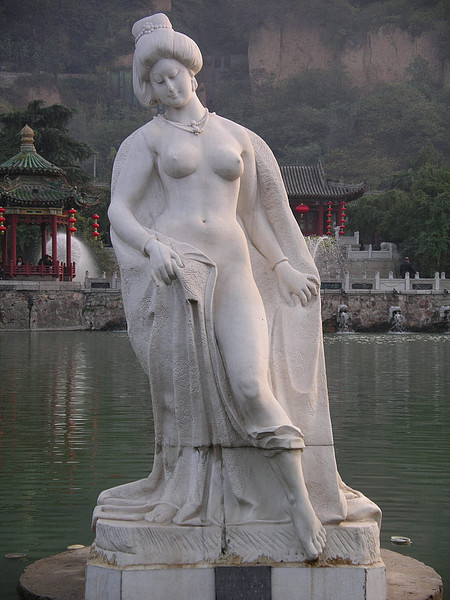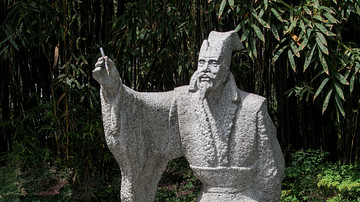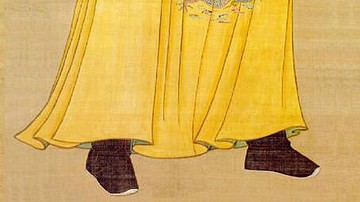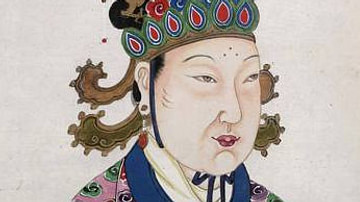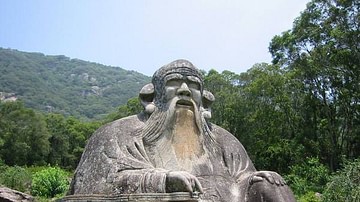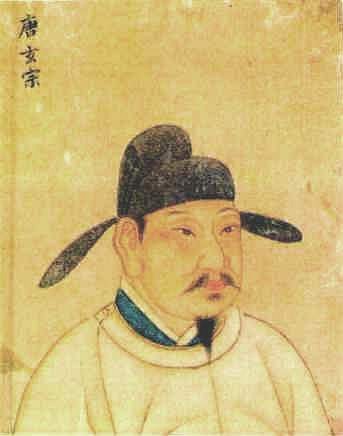
Xuanzong (birth name, Li Longji, l. 685-762 CE, r. 712-756 CE) was the 7th emperor of the Tang Dynasty of China, whose domestic and foreign policies established the Tang Dynasty as the Golden Age in Chinese history. Many of the most important cultural and scientific advancements China is famous for were made during Xuanzong's reign.
He increased trade and foreign commerce, which resulted in cross-cultural exchange of many new ideas and innovations. Xuanzong was a poet and writer, grandson of Empress Wu Zetian, and a gifted statesman, who initially took his responsibilities seriously and improved the lives of his people. He ruled for 43 years, and his accomplishments as emperor made him a legend long after his death. The last good emperor of the Tang Dynasty took his name to associate himself with Xuanzong's golden age of rule.
He is equally famous, though, as a literary character in the poet Bai Juyi's 806 CE work Song of the Everlasting Sorrow (also known as Song of Everlasting Regret) which tells the story of his tragic love affair with the Lady Yang. The Song of the Everlasting Sorrow was very popular in its time and remains one of the most popular Chinese poems in the present day. Xuanzong's relationship with Lady Yang would seriously compromise his abilities as emperor and contributed to his personal decline as well as that of the Tang Dynasty.
Early Life & Rise to Power
Li Longji was born in Luoyang in 685 CE, the third son of Ruizong (the second son of Empress Wu Zetian) and his concubine Consort Dou. Wu Zetian had married the emperor Gaozong (r. 649-683 CE) and taken control of the government after his death. She first placed her son Zhongzong on the throne in 684 CE and tried to rule through him but his wife, Lady Wei, had her own ambitions for power and got in the way so Wu Zetian had him removed and sent into exile. She, then, elevated Ruizong to emperor the same year and kept him under house arrest in the palace so he could not be influenced by others, especially other women.
Ruizong proved to be as disappointing to his mother as his brother had been and she exiled him as well in 690 CE and openly proclaimed herself head of state. Wu Zetian had Li Longji's mother (Consort Dou) and Ruizong's wife (Lady Liu) murdered in 693 CE, after they were falsely accused of plotting against her. Wu Zetian could have then had the rest of the family killed but instead kept Li Longji and his relatives under strict house arrest inside the palace. Li Longji was still considered a threat to Wu Zetian, and she would have had him killed but for the intervention of his aunt, Princess Taiping, Wu Zetian's daughter. Taiping took a special interest in the boy and guarded him from her mother's schemes.
Li Longji grew up in this strange atmosphere under his grandmother's close watch, practicing poetry and music, until 699 CE when he and his relatives were released. By this time, Wu Zetian's power was in decline and she was spending most of her time with two young men known as the Zhang Brothers who were her favorite lovers. She had begun to ignore affairs of state and showed signs of paranoia so, in 704 CE, court officials had the Zhang brothers murdered and forced Wu Zetian to abdicate in favor of her exiled son Zhongzong (r. 705-710 CE). Zhongzong returned with his wife, Lade Wei, and Wu Zetian retired, dying a year later.
While Zhongzong and Lady Wei began their rule, Li Longji took a position as secretary general in modern-day Shaanxi Province but was recalled to the capital of Chang'an in 710 CE to attend an important ceremony. When he arrived, diviners claimed they sensed the presence of the new emperor in the city but could not tell whether it was Li Longji or one of his relatives.
Lady Wei had watched Wu Zetian as empress closely and felt there was no reason she could not do what her mother-in-law had done. She grew tired of manipulating affairs through Zhongzong and poisoned him in 710 CE to make way for her son to rule. Princess Taiping was a highly influential member of the court at the time and, with the help of Li Longji, she stopped Lady Wei's coup before it could go any further. Taiping and Li Longji then had Wei and her son killed, along with any other conspirators, and Ruizong became the new emperor.
Ruizong declared that his eldest son, Li Chengqi, would succeed him, but Li Chengqi claimed the honor should go to his younger brother who had helped their father to the throne. Taiping's support for Li Longji ensured that he was made crown prince and successor to Ruizong. Taiping, like Lady Wei, had also closely observed her mother's reign and thought she could do likewise and rule through Li Longji.
She paid the court astrologers to interpret the celestial sign of a comet as meaning that the time had come for Ruizong to abdicate in favor in Li Longji, and in 712 CE Ruizong stepped aside, and his son became emperor, taking the name Xuanzong. Taiping was at first very pleased with this situation but soon found she could not manipulate Xuanzong as she had hoped. Feeling betrayed by him, and with no prospects of gaining the power she desired, she hanged herself.
Xuanzong's Reign
Under Xuanzong's reign the Tang Dynasty began its golden age. Under Taizong and Wu Zetian, Buddhism had been elevated as the most popular religion in the country, but Xuanzong saw Buddhist teachings as lacking in spirituality and so promoted Taoism and even decreed that "a copy of the Tao teaching be kept in every household (Wintle, 148)".
Xuanzong felt Buddhism placed too much emphasis on the individual at the expense of the community but that Taoism was a unifying belief which would promote greater harmony. According to scholar Justin Wintle, his religious and political reforms resulted in domestic tranquility which encouraged productivity and foreign trade.
Xuanzong abolished the death penalty, improved the economy through security on the Silk Road, increased maritme trading, decreed financial reforms, constructed temples and administrative complexes, built roads, and improved industry. He reorganized the military so that farmers were no longer conscripted against their will and built a professional army of veterans who were more effective in guarding the borders and reclaiming land from nomadic tribes.
Cultural Advancements
Xuanzong was a cultured man who patronized the arts and encouraged creative expression. Construction of the famous Leshan Giant Buddha, an enormous statue of a Maitreya (a future Buddha) was started in 713 CE under Xuanzong's reign. A Buddhist monk named Hai Tong began the project to ward off evil spirits from the river at the bottom of the cliffs. This statue of the Maitreya, carved into the cliff, is 233 feet (71 m) tall and remains a popular tourist attraction today. Even though Xuanzong did not support Buddhism, he encouraged artists like Hai Tong to create whatever they wanted.
Over 50,000 poems, plays, short stories, and other literary works were produced during the Tang Dynasty, mainly under Xuanzong's reign, and an encyclopedia was completed. Woodblock printing, which began on a large scale under Taizong, was improved, and more books became available, which led to greater literacy and better jobs for the lower classes since they were now eligible to take civil service exams for government jobs.
Public libraries were built to collect all the books in print and calendars were printed for wide distribution. Advances in medicine, such as recognized symptoms of a disease and how to treat it, were available now outside the medical profession. Medical books also suggested preventative habits and promoted diet as an important factor in one's health.
Technological advances led to the creation of clocks; the first clock mechanism in the world was invented by the engineer Yi Xing in 725 CE. Mechanical expertise also resulted in the creation of automatons, motorized figures, who moved by themselves through intricate mechanisms.
Even though motorized puppets had existed in China since the Qin Dynasty (221-206 BCE), the automatons of the Tang Dynasty were more complex and based on designs by Hero of Alexandria (l. c. 10-70 CE) who was famous for his inventions in Egypt. One example of Tang automatons was a motorized monk who collected donations, and another was an automatic wine-pourer shaped like a mountain which used a hydraulic pump.
The poor, who used to wear mainly animal skins, could now afford the linen worn by the middle class. The quality of life for the people of China improved dramatically, and the increase in trade brought new ideas, inventions, and products in greater numbers than ever before.
The Treachery of Li-Linfu
Xuanzong's reign was so successful because he understood how a balanced rule promoted fairness and justice, which improved the lives of everyone. One of Wu Zetian's most important government reforms, which Xuanzong kept, was placing people in high positions based on merit instead of family connections. Teachers were hired because they knew their subject, not because they were another official's cousin, and agricultural administrators were promoted to their position for the same reason, and so on with other appointments.
Xuanzong started to grow tired of public life c. 734 CE and began depending more on the advice of his consort, Lady Wu Hui-fei, who suggested he elevate a close friend of her family, Li-Linfu, to a more prominent position in order to take on some of the burden of rule. Li-Linfu was made chancellor, and since he was a close friend of the family, Xuanzong felt he could trust him but he was wrong. Li-Linfu was a corrupt and power-hungry man who only cared about advancing himself. While he played the part of the devoted servant of the emperor he schemed to seize power himself and depose Xuanzong.
The emperor suspected nothing and placed great trust in Li-Linfu. In 737 CE Consort Wu died, and Xuanzong withdrew further into his own pleasures and left the business of government to Li-Linfu. Xuanzong had over 4,000 of the most beautiful women brought to the palace for his pleasure and kept them imprisoned there to entertain him. All of these women were nothing, however, once he saw the one who would become his true love but who would also lead to his ruin.
Xuanzong & Lady Yang
In 741 CE, Xuanzong fell in love with a woman named Yang Guifei who was married to one of his sons. Yang left her husband and moved into the imperial palace with Xuanzong. He neglected his duties as emperor for this love affair and agreed to anything Lady Yang asked. She began with small requests which he granted, and these grew into larger demands until she got him to promote members of her family to important positions even though these people could not do the jobs. All of the important reforms and progress Xuanzong had made started to unravel as the members of Yang's family abused their positions and neglected their duties.
At the same time, the policy of using foreign nationals in the army (which had grown out of Xuanzong's military reforms) led to the promotion of some of these men to very high positions of command. Li-Linfu exploited this situation to place men loyal to him in command of the army, at the same time he was accepting bribes from Yang's family to appoint them to comfortable bureaucratic posts. The former prosperity of the country began to decline as the people in authority spent more time enjoying themselves than taking care of their responsibilities.
The An Lushan Rebellion
A half-Sogdian/half-Turk general named An Lushan saw the Yang family's abuses as a sign that Xuanzong was no longer fit to rule and the Tang Dynasty had lost the Mandate of Heaven which legitimized every dynasty. An Lushan commanded the best troops in the Chinese army and felt he had a duty to take action and lead these men to restore a proper government; so he mounted a rebellion against the ruling house in 755 CE. He overthrew Xuanzong and declared himself emperor. He was challenged by the Tang forces and his rebellion eventually crushed, but he had started something which could not be stopped. Between 755-763 CE the country was torn apart by wars in which close to 36 million people died.
Xuanzong fled the capital in 755 CE with Lady Yang and her family. The men of the military escort who accompanied them blamed Yang for the troubles and murdered her family en route. The commanders of the army then demanded that Lady Yang be killed also. Xuanzong refused but the men would not back down, and he had no choice but to comply. He admitted he had allowed himself to be seduced away from his duties and consented that Lady Yang should be strangled.
The story of their love affair and Yang's death was later romanticized by the popular poem Song of the Everlasting Sorrow by Bai Juyi in 806 CE. In the poem, Lady Yang gives her life willingly so the emperor can protect the kingdom from invading armies. Although the emperor is victorious, he cannot recover from his loss and mourns her the rest of his life. Lady Yang's death may not have been as romantic or self-sacrificing as Bai Juyi depicted it but it is true that Xuanzong never recovered from it. After she was killed, he abdicated in favor of his son, Li Heng, who became Emperor Suzong (r. 756-762 CE) and took control of the army against the forces of An Lushan.
Later Life & Death
Suzong was a capable leader but no match for the superior forces of An Lushan. No matter what he tried, he could not win a victory, and the rebel forces grew stronger. Suzong and his father became more and more depressed and frustrated as Suzong's strategies failed. Xuanzong died from illness in 762 CE, and Suzong died from the same sickness less than two weeks later.
He was succeeded by his son Li Yu who became Emperor Daizong (r. 762-779 CE). Daizong crushed the An Lushan rebellion in 763 CE but the country was in ruins and the traditional respect given the emperor and royal house was compromised. Independent warlords now ruled different parts of China and Daizong could not command the kind of authority Xuanzong had at the beginning of his reign.
Almost a hundred years after his death, a man named Li Chen became emperor of China and took the name Xuanzong to honor his great predecessor. Xuanzong II is considered the last good emperor of the Tang Dynasty who modeled his reign on that of the great Taizong while trying to recreate the glory of the early years of Xuanzong and the golden age of the Tang Dynasty.
